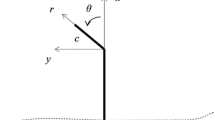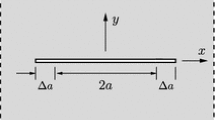Abstract
In this paper, the criteria of mixed mode brittle fracture are carefully examined. It has been shown that, the circumferential strain factor criterion is rational and safe.
With the exception of opening mode, mixed mode plane strain fracture of comparatively ductile materials(metals), in general, does not follow the theory of linear elastic fracture mechanics.
Like the stress intensity factor that which is concerned is playing an important role in pure opening mode crack problems. We believe that, in mixed mode crack problems, the circumferential strain factor will become a parameter to determine the rate of fatigue crack propagation per cycle, and of stress corrosion cracking per unit time.
Similar content being viewed by others
References
Griffith, A. A., The phenomena of rupture and flow in solids, Phil. Trans. Roy. Soc. (London) A221 (1921) pp. 163–198. (Read on Feb. 26, 1920. Published on Oct. 21, 1920).
Irwin, G. R., Analysis of stresses and strains near the end of a crack traversing a plate, Trans. ASME, J. Appl. Mech., 24 (1957) pp. 361–364.
Orowan, E., Fracture and strength of solids, Reports on Progress in Physics, Phy. Soc., (London), 12 (1949) pp. 185–232.
Erdogan, F. and Sih, G. C., On the crack extension in plates under plane loading and transverse shear, Trans. ASME, J. Basis Engg., 85 (1963) pp. 512–527.
Sih, G. C. and MacDonald, B., What the designer must know about fracture mechanics, Lehigh University Report IFSM 72-23, Nov. 1972.
Sih, G. C., Strain-energy-density factor applied to mixed mode crack problems, Intern. J. Fract., 10 (1974) pp. 305–321.
Sih, G. C., Introductory chapter: Strain energy density theory applied to plate bending problems, Mechanics of Fracture III, Leyden, (1977) pp. 17–48.
Institute of Mechanics, Academia Sinica, A new mixed mode fracture criterion, Mechanics, (1976) pp. 98–103 (in Chinese).
Hussain, M. A., Pu, S. L. and Underwood, J., Strain energy release rate for a crack under combined mode I and II, Fracture Analysis, ASTM STP 560 (1974) pp. 2–28.
Finnie, I. and Weiss, H. D., Some observations on Sih's strain energy density approach for fracture prediction, Intern. J. Fract., 10 (1974) pp. 136–138.
Sih, G. C., Discussion on Finnie's paper, Intern. J. Fract., 10 (1974) pp. 279–283.
Duquette, D. J., A review of aqueous eoriosion fatigue, Corrosion Fatigue, NACE-2, (1971) pp. 12–24.
Williams, J. G. and Ewing, P. D., Fracture under complex stress — The angled crack problems, Intern. J. Fract. Mech., 8 (1972) pp. 441–446.
Author information
Authors and Affiliations
Additional information
Communicated by Chien Wei-zang.
First published in Nanking Aeronautical Institute Report of Science and Technology, No. 680, Jan., 1980 (in Chinese).
Rights and permissions
About this article
Cite this article
Wei-xun, F. On the circumferential strain factor criterion of mixed mode brittle fracture. Appl Math Mech 3, 233–253 (1982). https://doi.org/10.1007/BF01877659
Received:
Issue Date:
DOI: https://doi.org/10.1007/BF01877659




